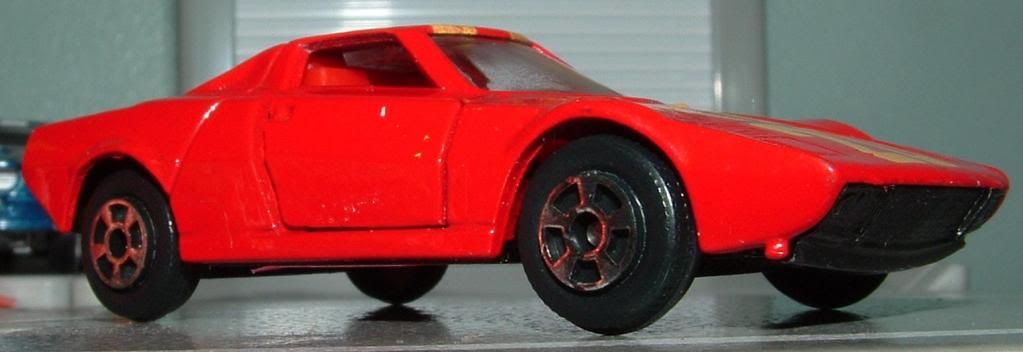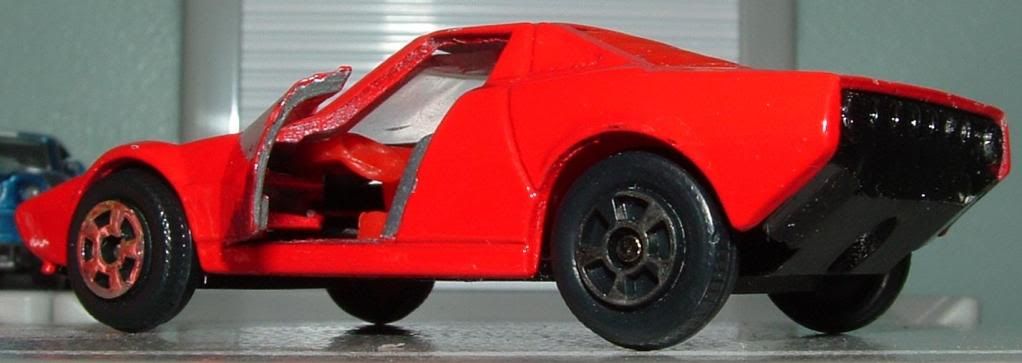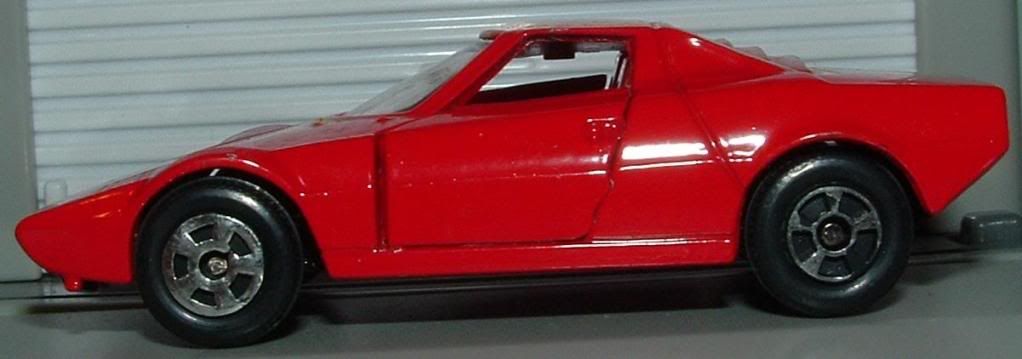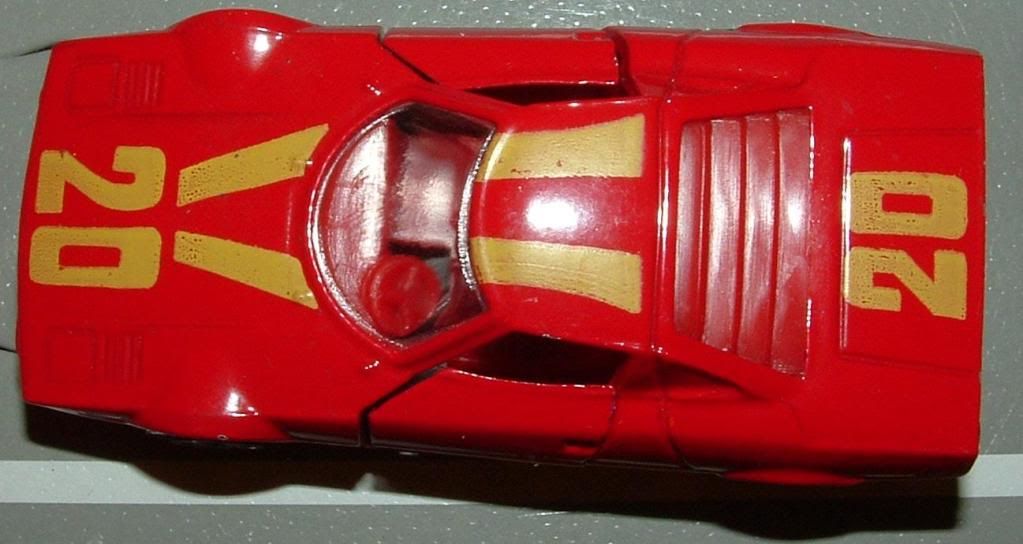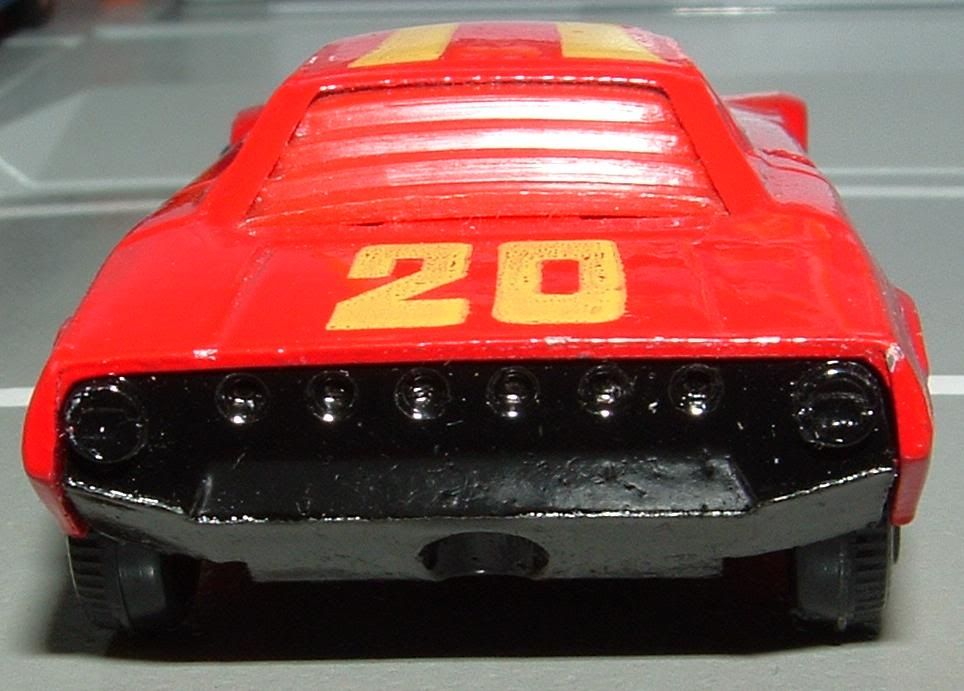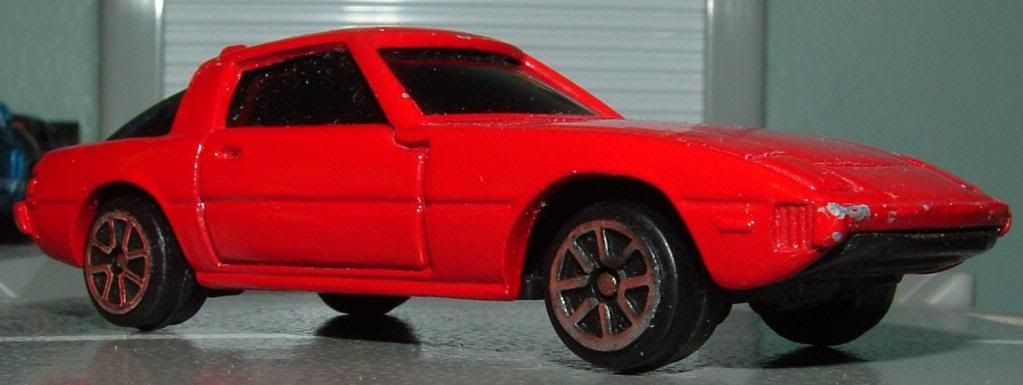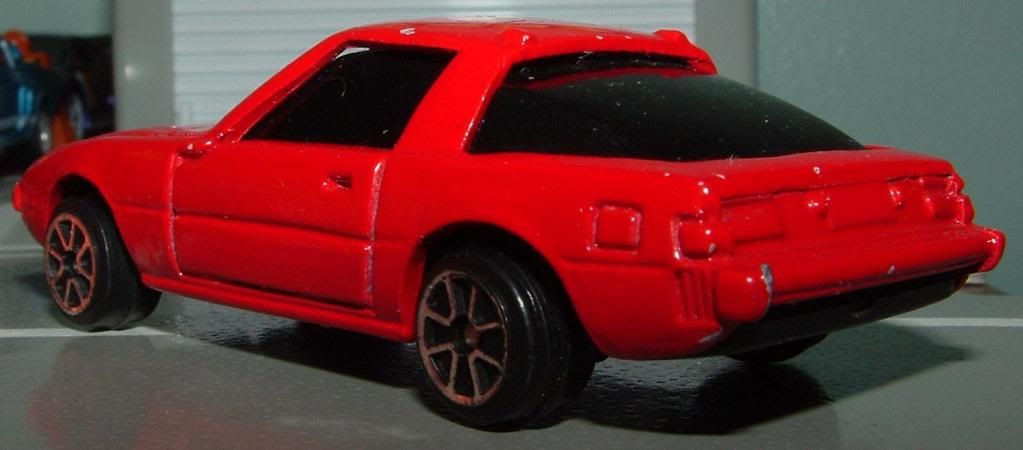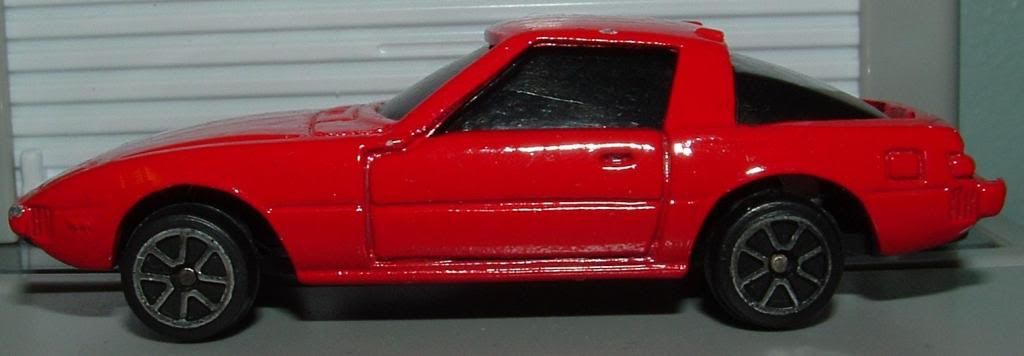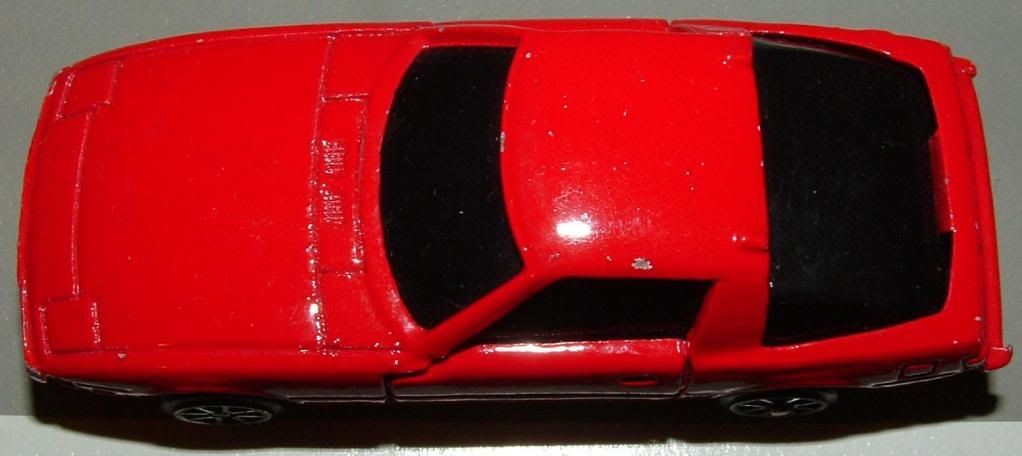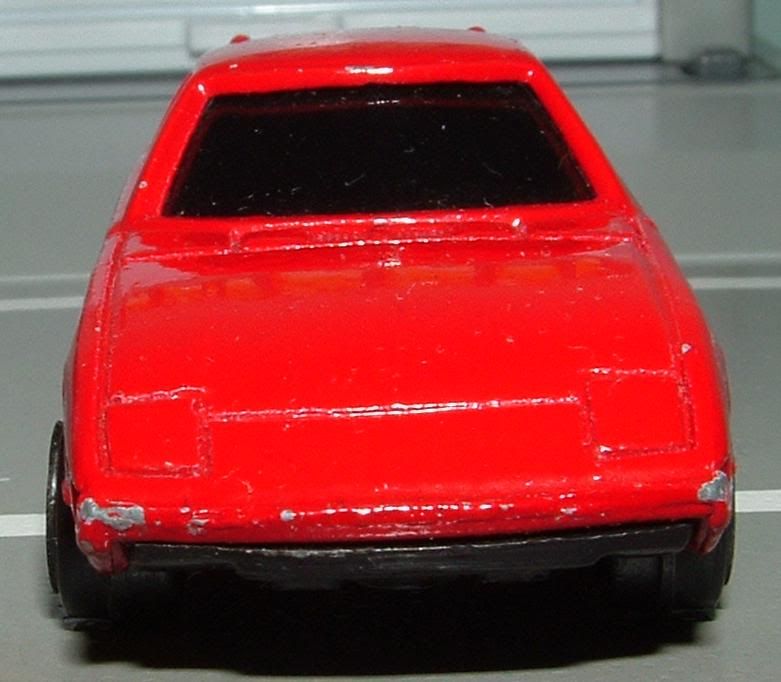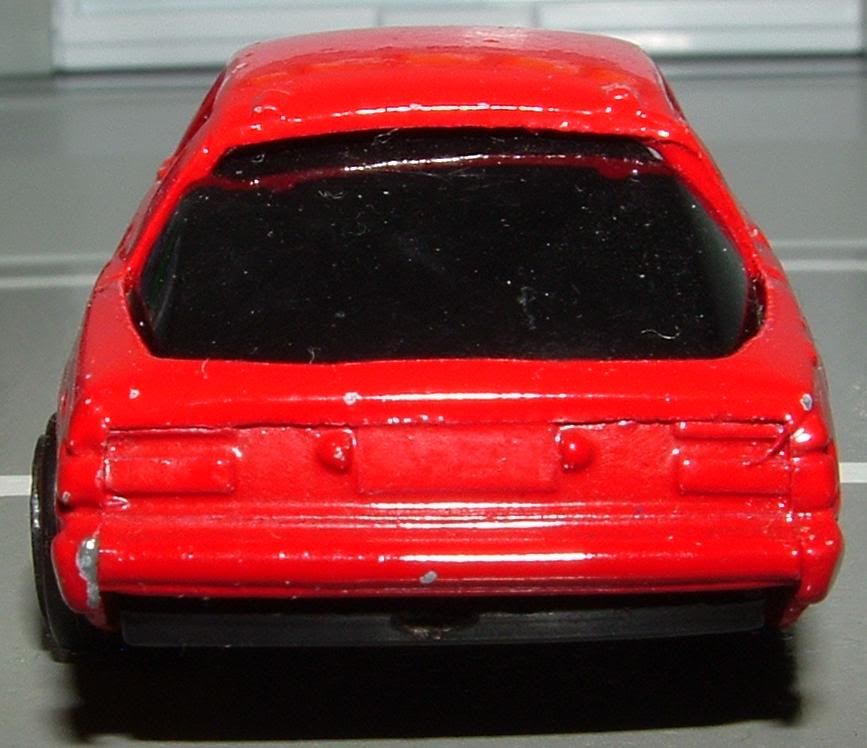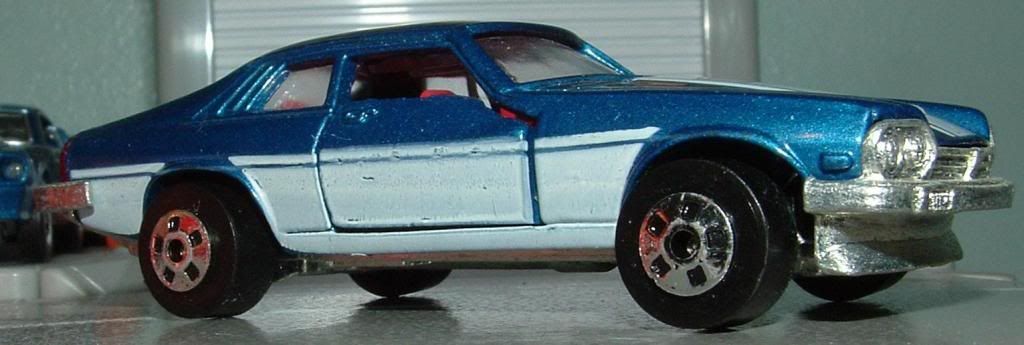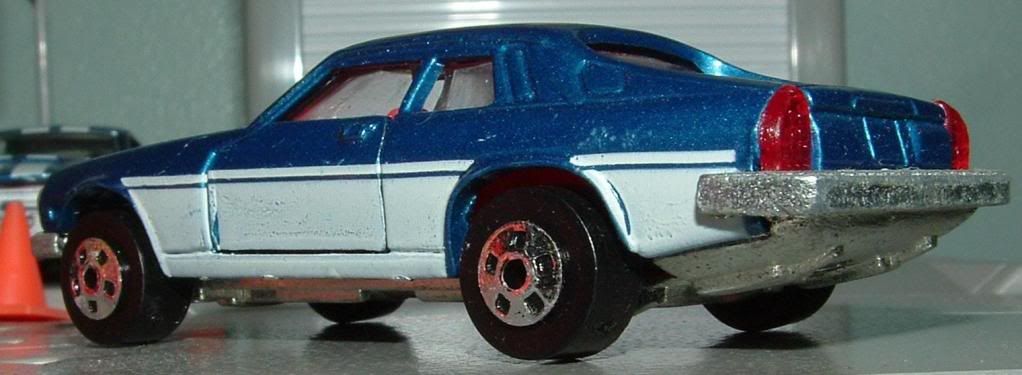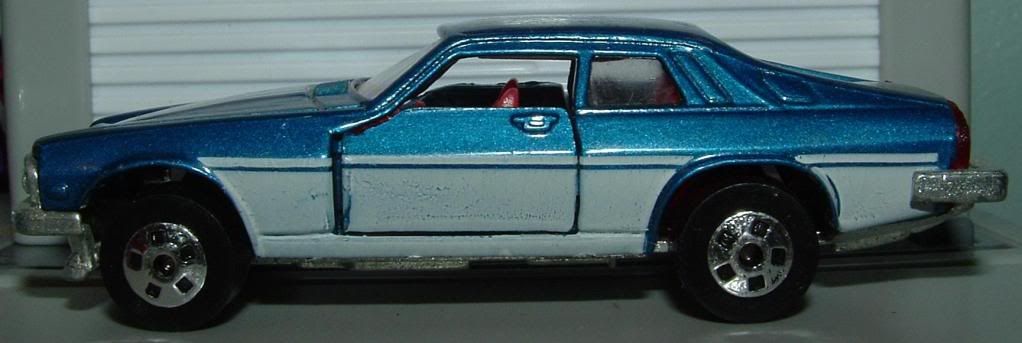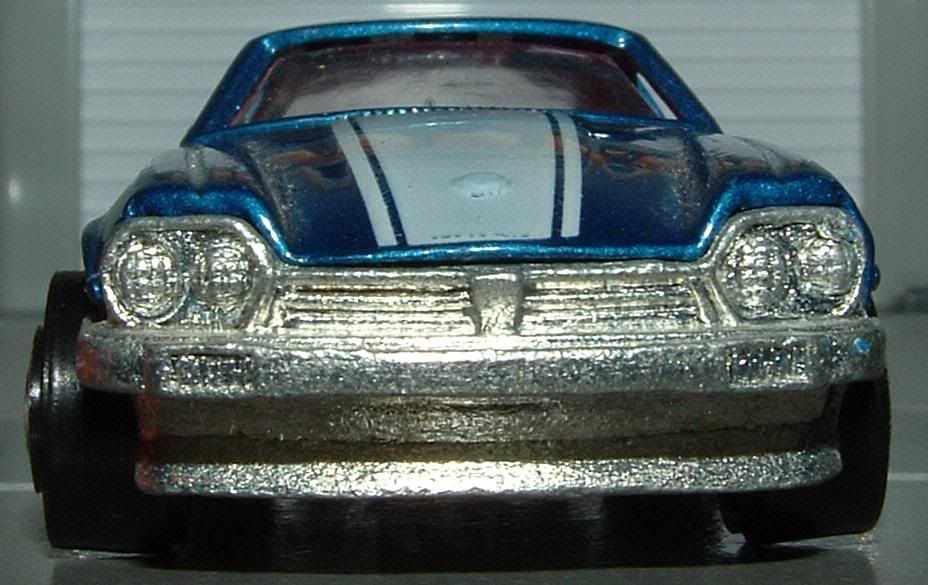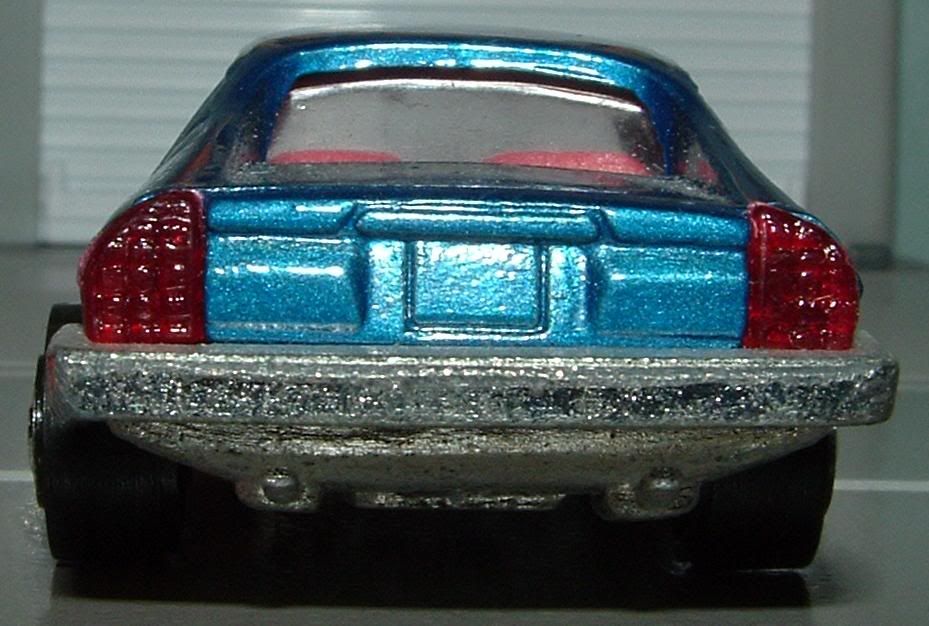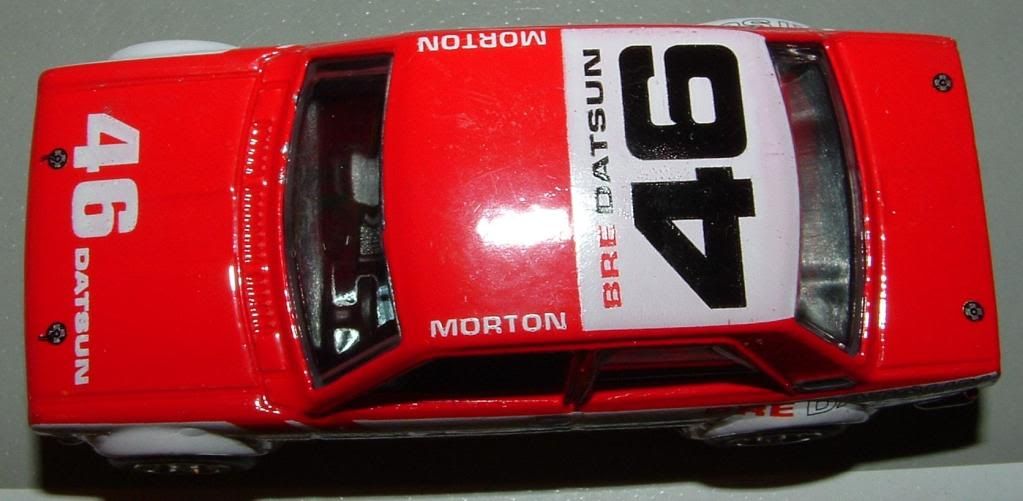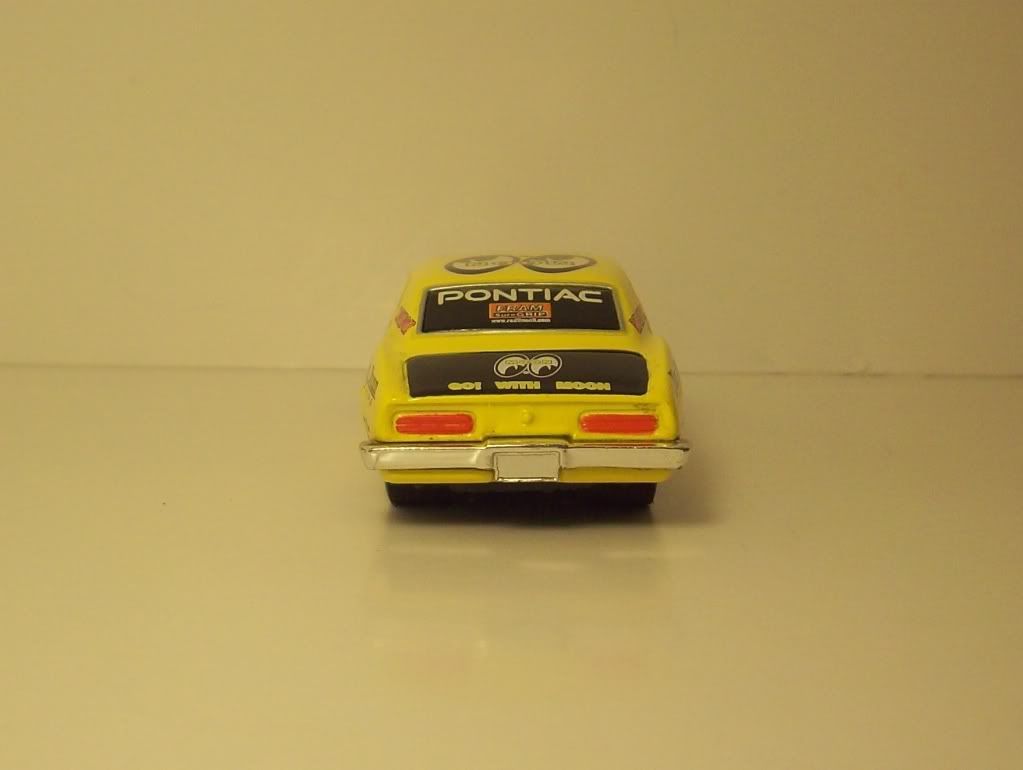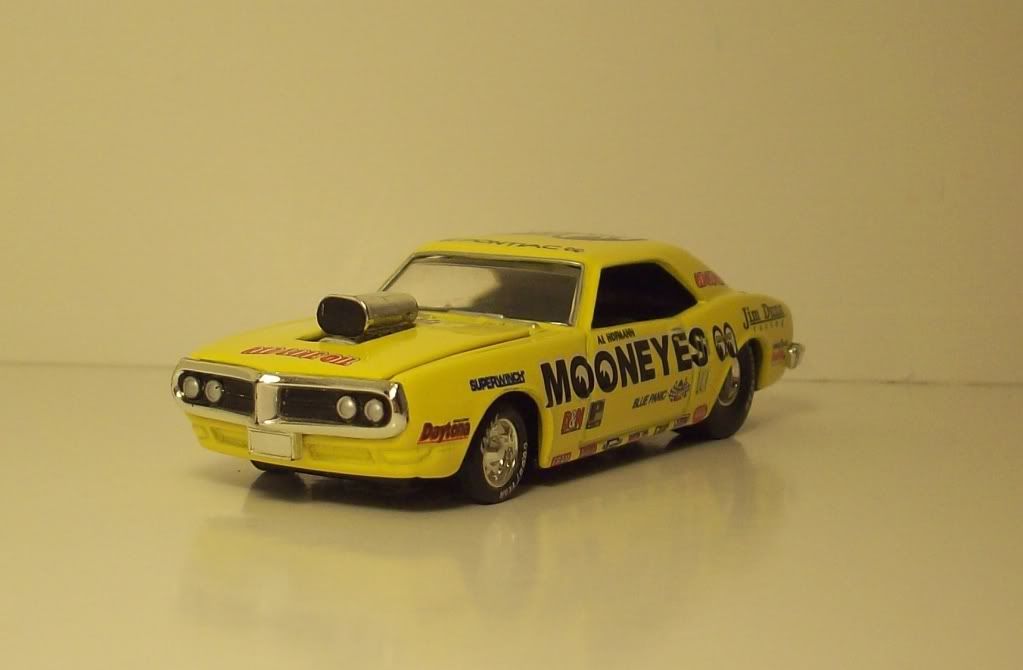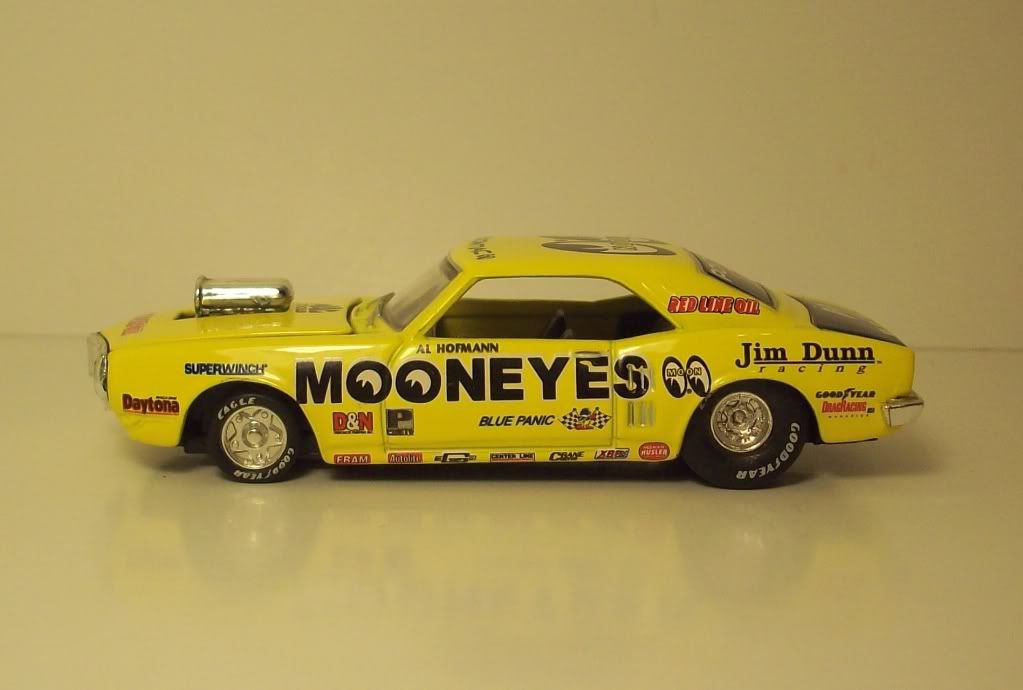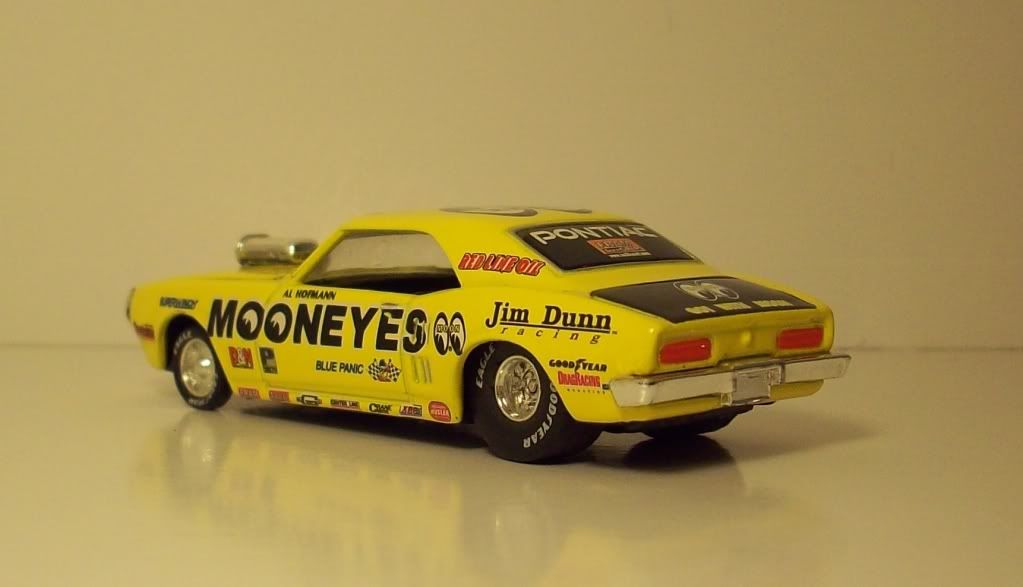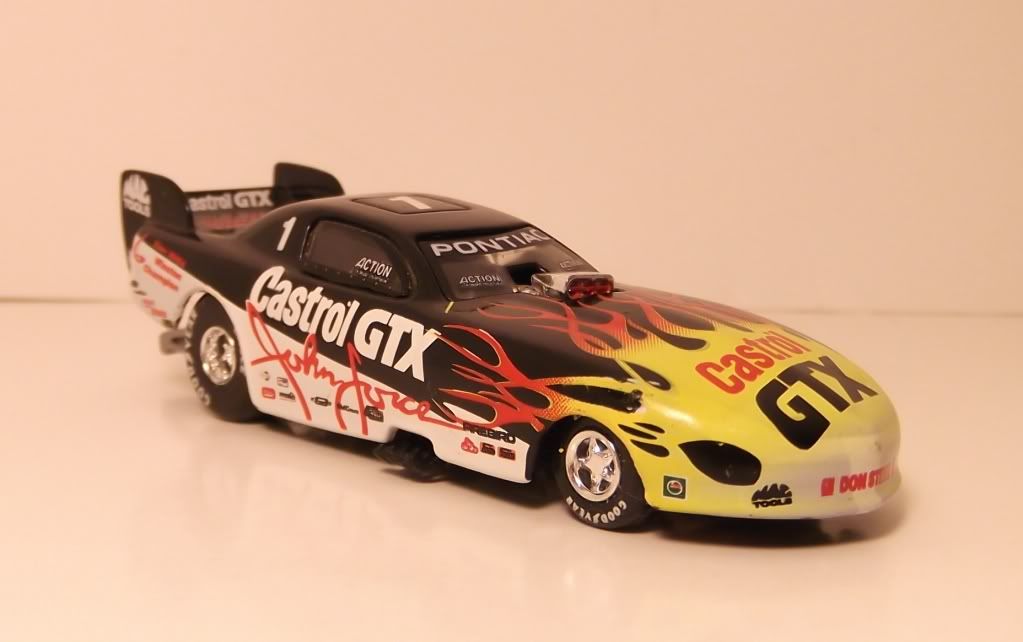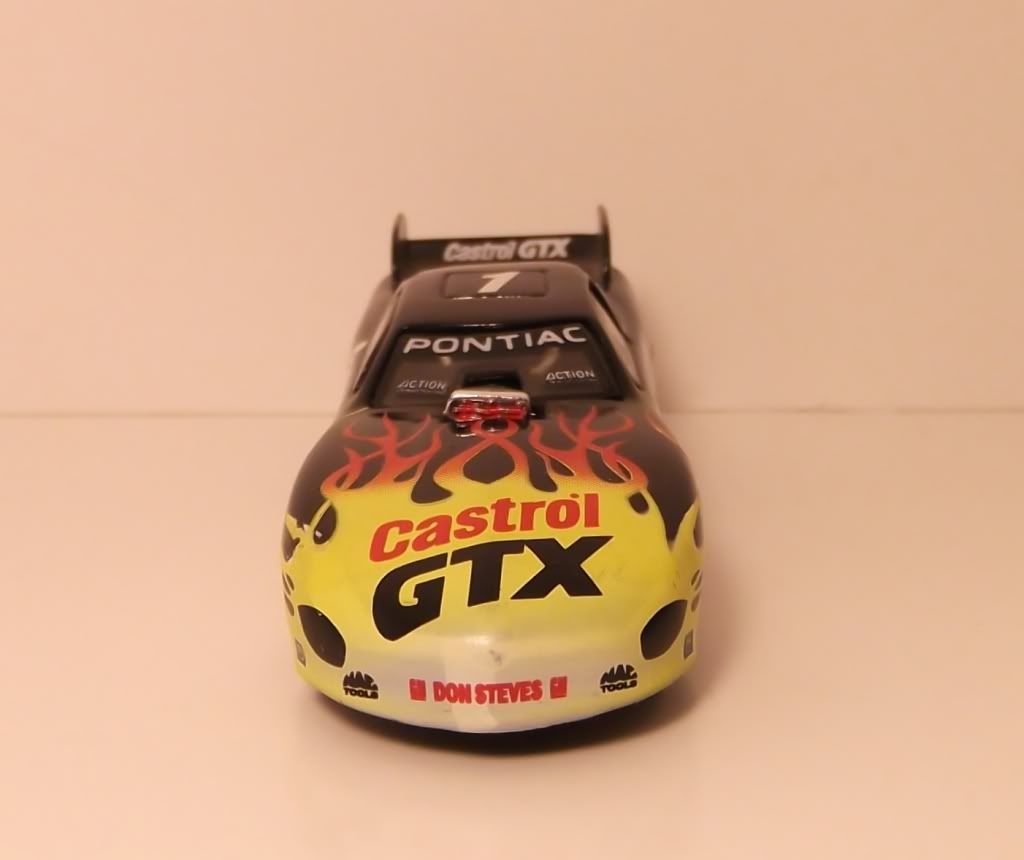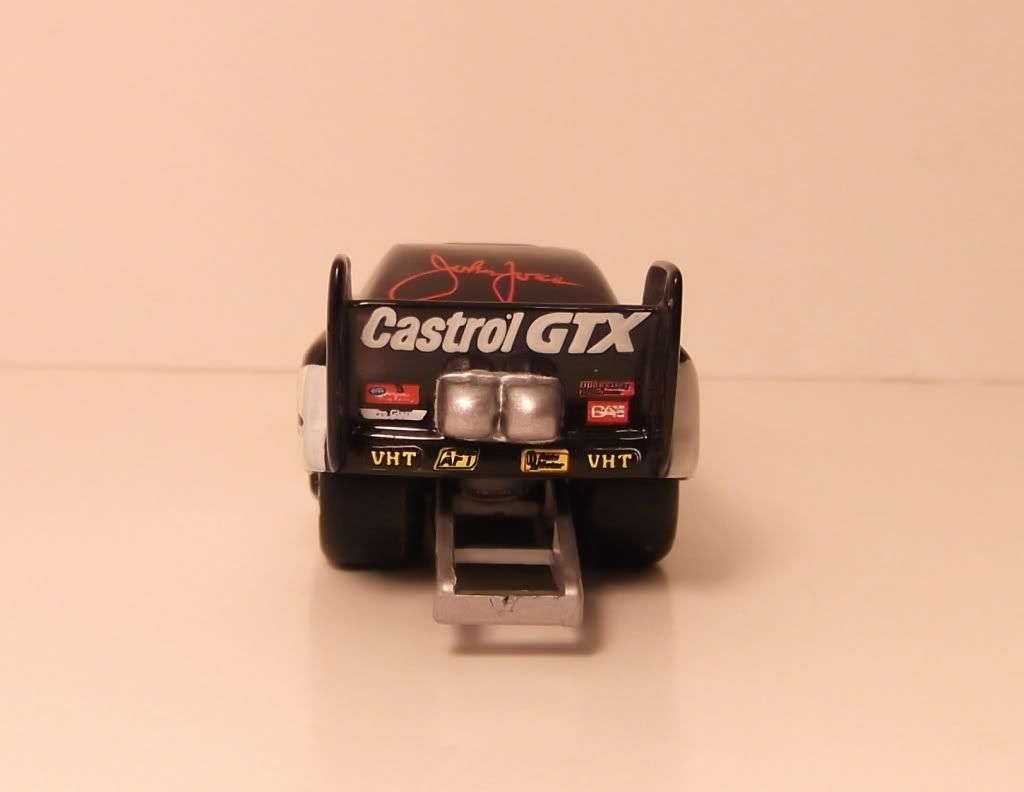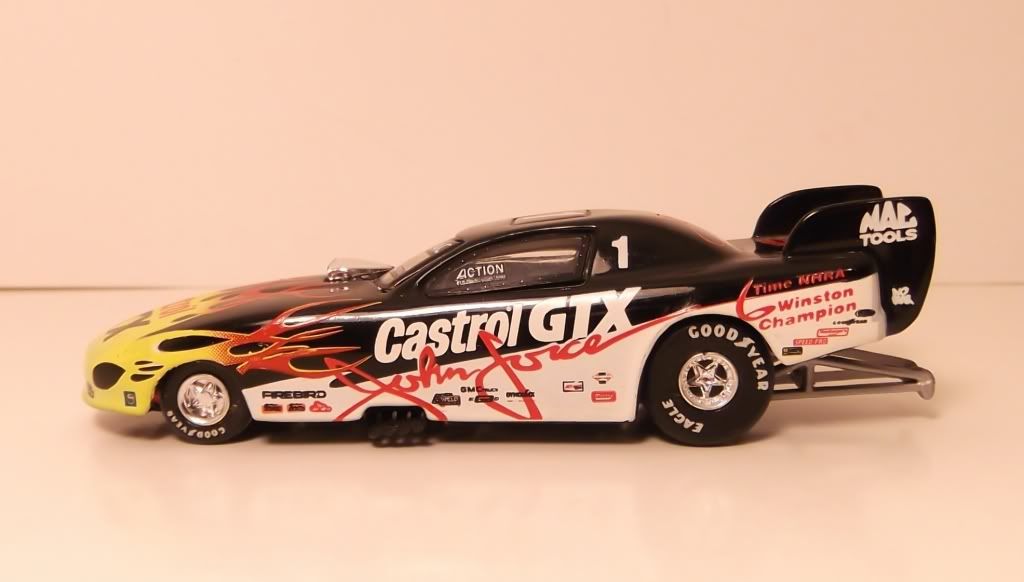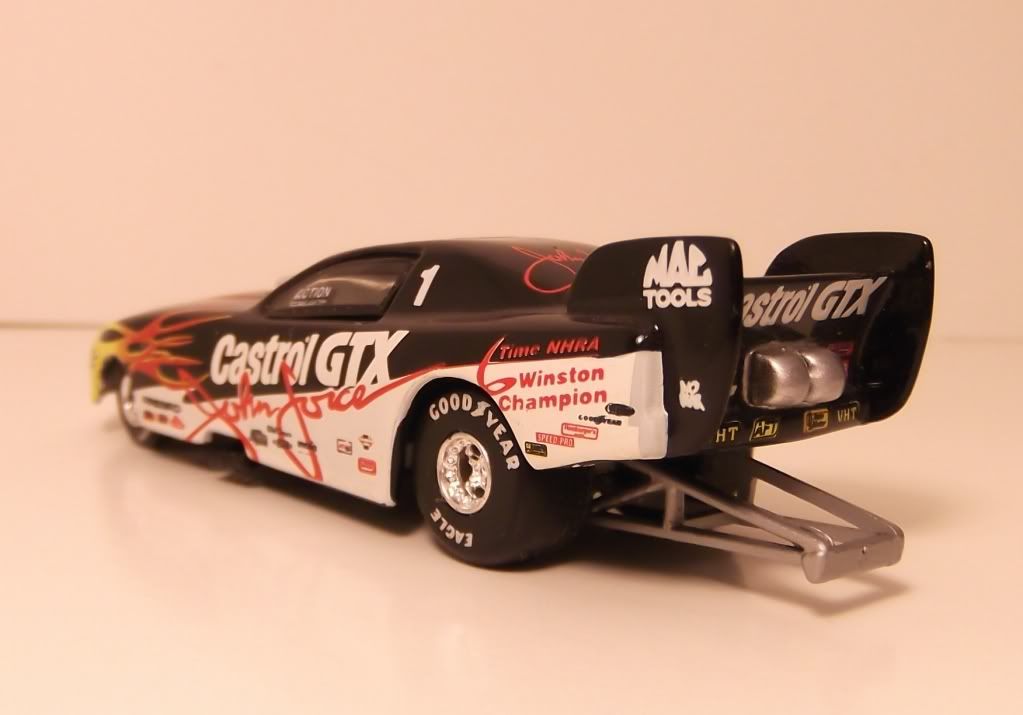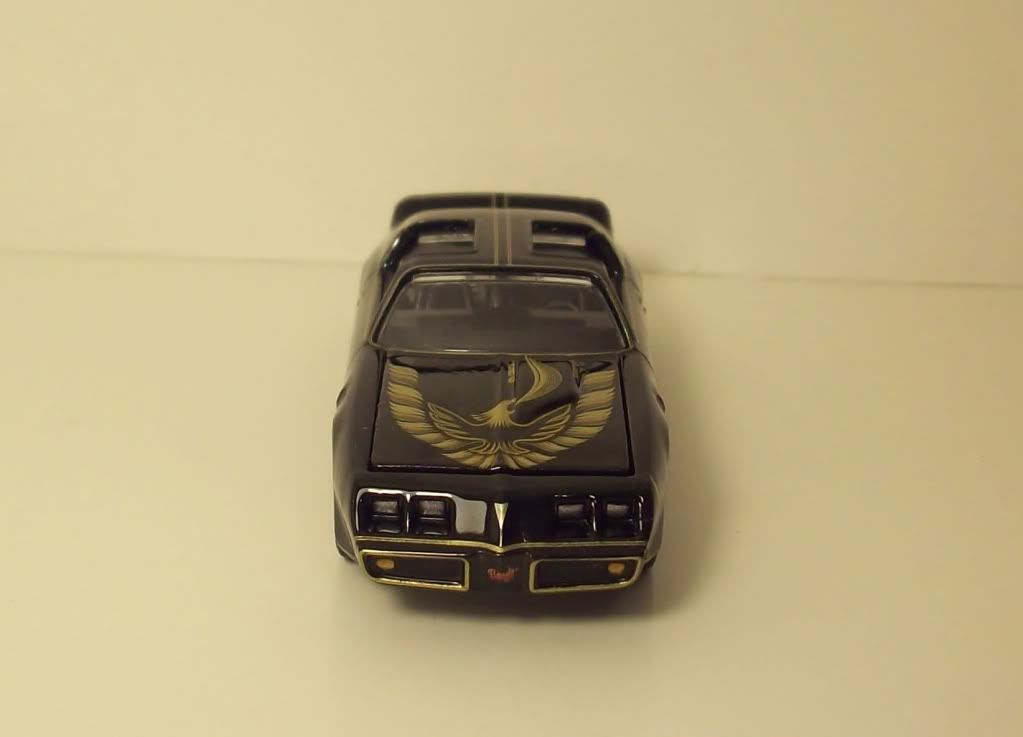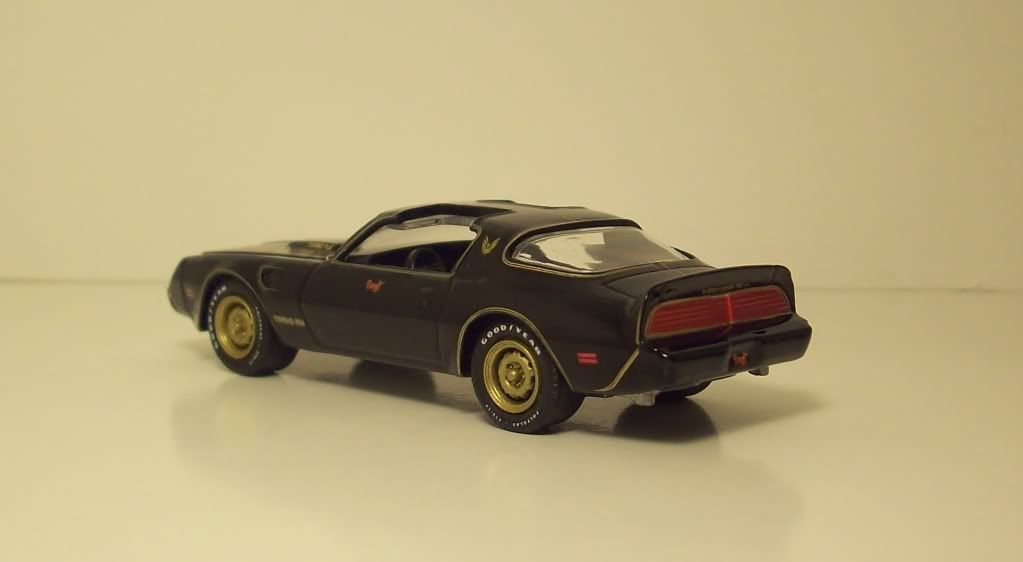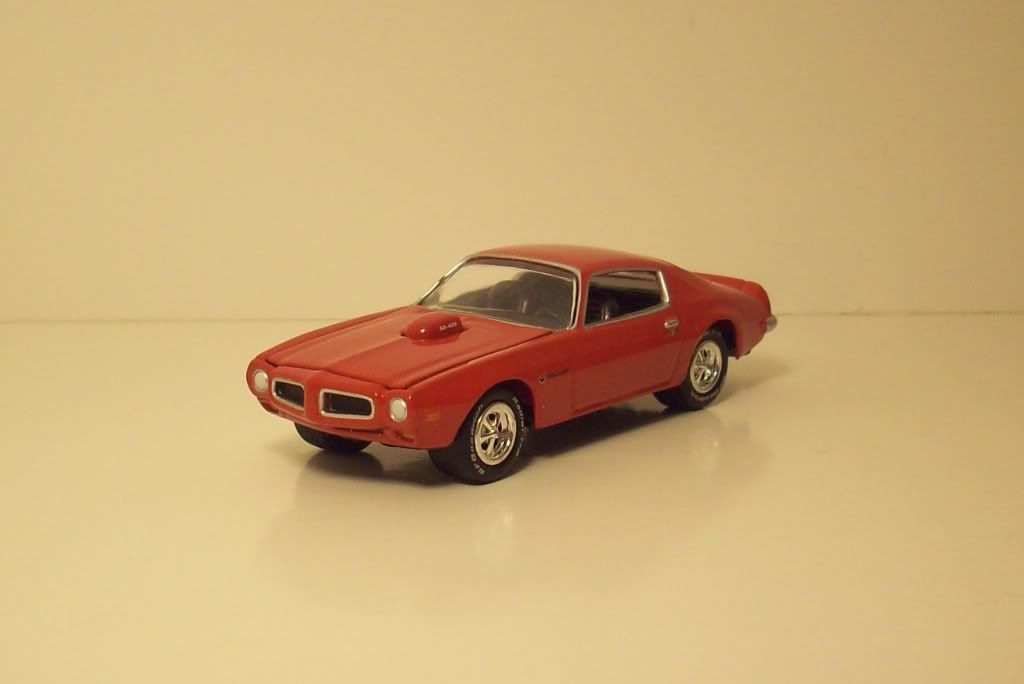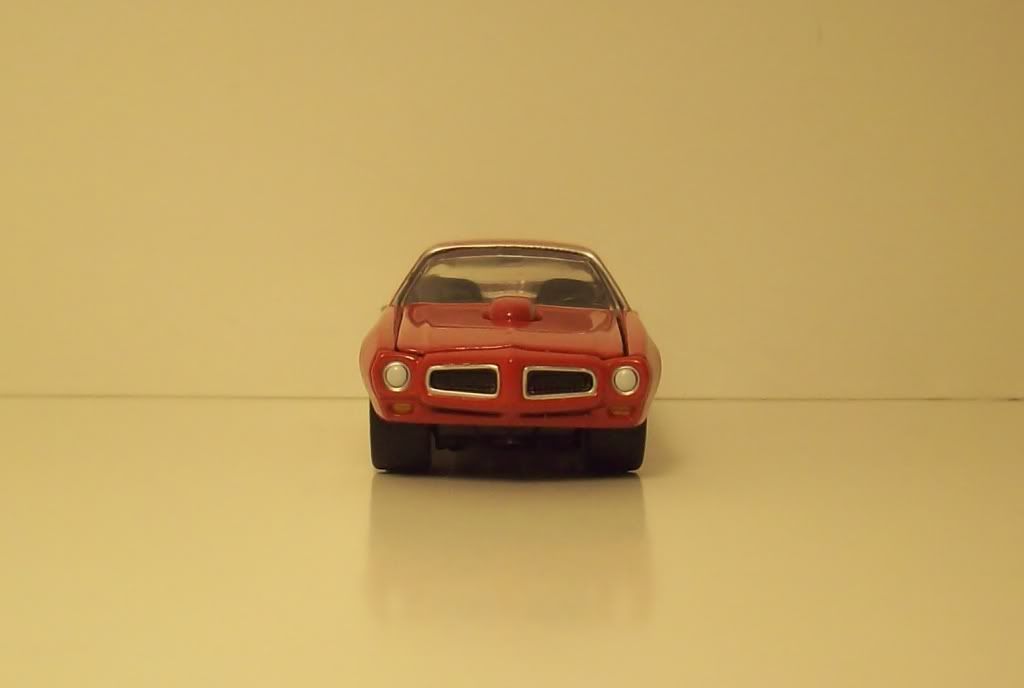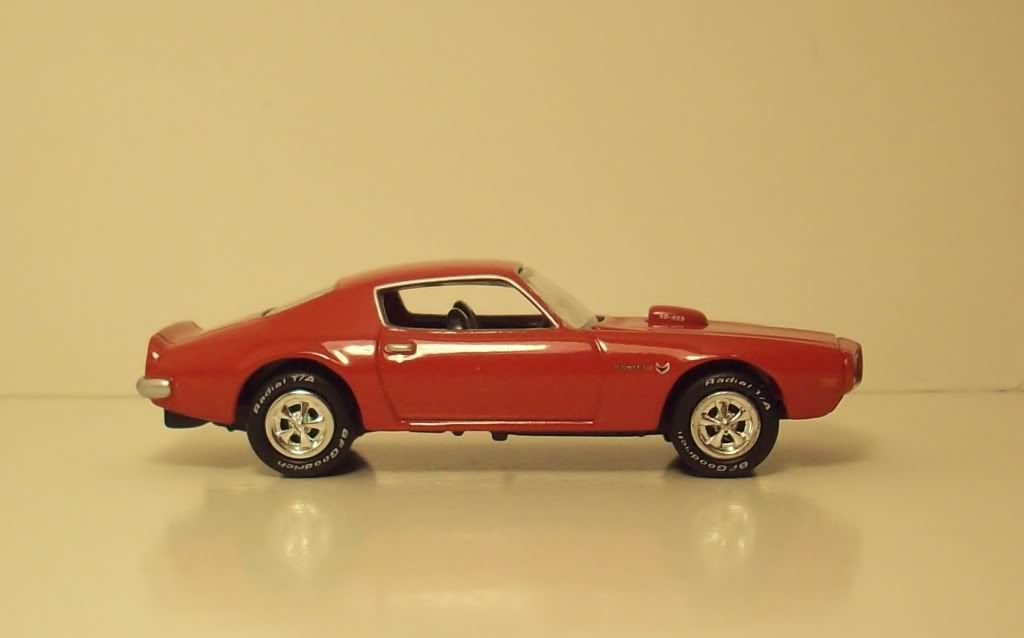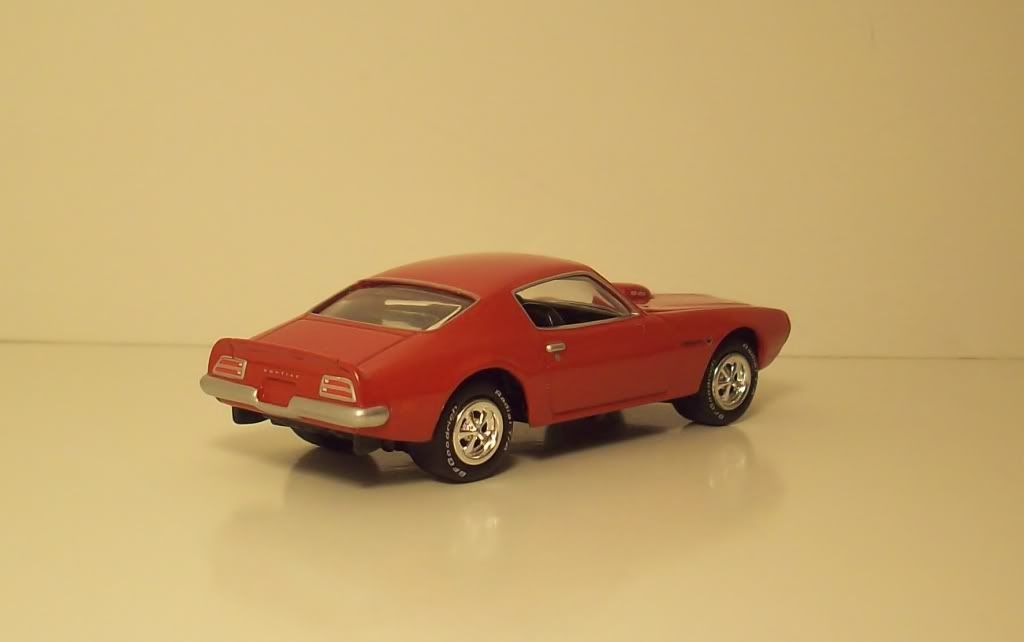
A blog focusing on 1/64 diecast from such popular brands as Hot Wheels, Matchbox, Johnny Lightning, M2 Machines, GreenLight, Tomica, Yat Ming, Majorette, MotorMax, Siku, Corgi, Guisval, Playart, Ertl, Zylmex, Racing Champions, & many more. Swifty's Garage features a daily Car Of The Day and news updates from your favorite brands!
Wednesday, November 30, 2011
Car Of The Day: November 30, 2011
Today's car of the day is Playart's 1975 Lancia Stratos HF.
The Lancia Stratos HF, widely and more simply known as Lancia Stratos, is a car made by Italian car manufacturer Lancia. The HF stands for High Fidelity. It was a very successful rally car, winning the World Rally Championship in 1974, 1975, and 1976.
A Bertone designed concept car called the Lancia Stratos Zero was shown to the public in 1970, but shares little but the name and mid-engined layout with the Stratos HF version. An new car called the New Stratos was announced in 2010 which was heavily influenced by the design of the original Stratos, but was based on a Ferrari chassis and engine.
For more information and pictures of the real car please visit: Lancia Stratos HF
The Stratos is one of my favorite cars, and the York toy show provided this example at a price I couldn't pass up.
Lancia presented the Bertone designed Lancia Stratos HF prototype at the 1971 Turin Motor Show, a year after the announcement of the Stratos Zero concept car. The prototype Stratos HF (Chassis 1240) was fluorescent red in colour and featured a distinctive crescent-shaped-wrap-around windshield providing maximum forward visibility with almost no rear visibility. The prototype had three different engines in its early development life: the Lancia Fulvia engine, the Lancia Beta engine and finally for the 1971 public announcement, the mid-mounted Dino Ferrari V6 producing 192 hp (143 kW).
The Stratos was a very successful rally car during the 1970s and early 1980s. It started a new era in rallying as it was the first car designed from scratch for this kind of competition. The three leading men behind the entire rallying project were Lancia team manager Cesare Fiorio, British racer/engineer Mike Parkes and factory rally driver Sandro Munari.
Lancia did extensive testing with the Stratos and raced the car in several racing events where Group 5 prototypes were allowed during the 1972 and 1973 seasons. Production of the 500 cars required for homologation in Group 4 commenced in 1973 and the Stratos was homologated for the 1974 World Rally Championship. The Ferrari Dino V6 engine was phased out in 1974, but 500 engines among the last built were delivered to Lancia. Production ended in 1975 when it was thought that only 492 were made.
Manufacturer of the car was Bertone in Turin, with final assembly by Lancia at the Chivasso plant. Powered by the Dino 2.4 L V6 engine that was also fitted to the rallying versions, but in a lower state of tune, it resulted in a power output of 190 bhp (142 kW; 193 PS), giving the road car a 0-60 mph time of just under five seconds, and a top speed of 144 mph (232 km/h). The car was sold as the Lancia Stratos Stradale.
For racing, the engine was tuned up to 280 hp (209 kW) and even to 560 hp (418 kW) with a single KKK turbocharger. However, turbocharged versions were only allowed to compete in Group 5 and were never as reliable as their naturally aspirated counterparts.
The car won the 1974, 1975 and 1976 championship titles in the hands of Sandro Munari and Björn Waldegård, and might have gone on to win more had not internal politics within the Fiat group placed rallying responsibility on the Fiat 131 Abarths. As well as victories on the 1975, 1976 and 1977 Monte Carlo Rally, all courtesy of Munari, the Stratos won the event with the private Chardonnet Team as late as 1979.
Without support from Fiat, and despite new regulations that restricted engine power, the car would remain a serious competitor and proved able to beat works cars in several occasions when entered by an experienced private team with a talented driver. The final chapter of the Stratos' racing career at international level took place as late as 1981, at the Tour de Corse Automobile, another World Rally Championship event, with a victory by longtime Stratos privateer Bernard Darniche.
When the Fiat group favored the Fiat 131 for rallying Lancia also built two Group 5 turbocharged 'silhouette' Stratos for closed-track endurance racing. These cars failed against the Porsche 935s on closed tracks but proved successful in hybrid events. While they failed in the Tour de France Automobile, one of these cars won the 1976 Giro d'Italia Automobilistico, an Italian counterpart of the Tour de France Automobile. Unfortunately one of the cars was destroyed in Zeltweg, when it caught fire due to overheating problems. The last surviving car would win the Giro d'Italia event again before it was shipped to Japan to compete in the Fuji Speedway based Formula Silhouette series, which was never raced. The car would then be sold and reside in the Matsuda Collection before then being sold to the renowned collector of Stratos', Christian Hrabalek, a car designer and the founder of Fenomenon Ltd, who has the largest Lancia Stratos Collection in the world, 11 unique Lancia Stratos cars, including the fluorescent red 1971 factory prototype and the 1977 Safari Rally car. His interest in the car led to the development of the Fenomenon Stratos in 2005.
Another unique Group 5 car is the Lancia Stratos HF of Austrian Rallycross driver Andy Bentza. The car was first driven by his Memphis team mate Franz Wurz, father of Formula One pilot Alexander Wurz. In 1976 Wurz claimed the first ever European Rallycross title recognised by the FIA with the car, by then still equipped with a 2.4 litre engine. For the ERC series of 1977 Wurz was entrusted with two experimental crankshafts by Mike Parkes, to bring the engine capacity up to just under 3000 cc. For 1978 Bentza took the Stratos over from Wurz, sold his own 2.4 litre Stratos to compatriot Reneé Vontsina, and won the GT Division title of the ERC. The one and only 3.0 litre Stratos was raced by Bentza till the mid 1980s, is nowadays still his property and ready to race. However, one of the two experimental crankshafts received from the Lancia factory was destroyed during a Rallycross event in the early 1980s.
Tuesday, November 29, 2011
Car Of The Day: November 29, 2011
Today's car of the day is (you tell me)'s 1979 Mazda RX-7.
The Mazda RX-7 is a sports car by the Japanese automaker Mazda. It was produced from 1978 to 2002. The original RX-7 featured a 1146 cc twin-rotor Wankel rotary engine and a sporty front-midship, rear-wheel drive layout. The RX-7 was a direct replacement for the RX-3 (both were sold in Japan as the Savanna) and subsequently replaced all other Mazda rotary cars with the exception of the Cosmo.
The original RX-7 was a sports car. The compact and lightweight Wankel engine (rotary engine) is situated slightly behind the front axle, a configuration marketed by Mazda as "front mid-engine". It was offered as a two-seat coupé, with optional "occasional" rear seats in Japan, Australia, the United States, and other parts of the world. These rear seats were initially marketed as a dealer-installed option for the North American markets.
The RX-7 made Car and Driver magazine's Ten Best list five times. In total, 811,634 RX-7s were produced.
For more information and pictures of the real car please visit: Mazda RX-7
A pretty nice casting, but the manufacturer declined to identify themselves on the base. Any ideas?
Series 1 (1979–1980) is commonly referred to as the "SA22C" from the first alphanumerics of the vehicle identification number. This series of RX-7 had exposed steel bumpers and a high-mounted indentation-located license plate, called by Werner Buhrer of Road & Track magazine a "Baroque depression."
In 1980 Mazda released 2500 special North American models known as the LS (Leather Sport). This package was essentially an uprated "GS" model with added LS badges on each B-pillar, unequal width dual gold pinstripe detail, full special brown leather upholstery, sunroof, AM/FM stereo radio, and LS-only gold center colored alloys. Two GS package options were also available; three speed automatic transmission and air conditioning. This model was only available in three different colors: Aurora White (1000 made), Brilliant Black (1000 made) and Solar Gold (500 made). Production estimates in parenthesis are widely accepted estimations per color, though no official production records are known to exist or to have been released, aside from the total combined production figure of 2500 units.
Monday, November 28, 2011
Car Of The Day: November 28, 2011
Today's car of the day is Road Champs' 1985 Jaguar XJS.
The Jaguar XJ-S (later the Jaguar XJS) is a luxury grand tourer produced by the British manufacturer Jaguar from 1975 to 1996. The XJ-S replaced the E-Type (or XK-E) in September 1975, and was based on the XJ saloon. It had been developed as the XK-F, though it was very different in character from its predecessor. Although it never had quite the same sporting image, the XJ-S was a competent grand tourer, and more aerodynamic than the E-Type. The last XJS was produced on 4 April 1996, by then 115,413 had been produced during a 21-year production life. The model was replaced by the XK8.
For more information and pictures of the real car please visit: Jaguar XJS
One of the best Jaguar XJS models in small scale.
The first XJ-S appeared in 1975 as a 1976 model. Power came from the Jaguar V-12 petrol engine with a choice of a manual or automatic transmission, but the manual was soon dropped. V-12 automobiles were unusual at the time, with notable others coming from Italian luxury sports car makers Lamborghini and Ferrari. The specifications of the XJ-S compared well with both Italian cars; it was able to accelerate to 60 mph (97 km/h) in 7.6 seconds (automatic) and had a top speed of 143 mph (230 km/h). The first series of XJ-S cars had a Borg-Warner Model 12 transmission with a cast iron case and a bolt-on bell-housing. In 1979 GM Turbo-Hydromatic 400 transmissions were fitted. The TH400 transmission was an all aluminium alloy case with an integrated non-detachable bell-housing.
Jaguar's timing was not good; the car was launched in the wake of a fuel crisis, and the market for a 5.3 litre V12 grand tourer was very small. The styling was also the subject of criticism, including the buttresses behind the windows. German authorities feared these would restrict rearward vision, and refused to give the model (along with a similarly adorned contemporary Lancia model) type approval: it was for a time necessary instead for German XJS buyers to obtain type approval for each individual car when registering it. Such fears were ill founded, since in reality the rear visibility was very reasonable, with only the frontmost top edges of the buttresses being visible, when looking rearward.
Jaguar did seize promotional opportunities with the television series The New Avengers and Return of the Saint. The New Avengers featured Mike Gambit (Gareth Hunt) who drove an XJ-S. Return of the Saint saw Simon Templar (played by Ian Ogilvy) driving an early XJ-S with the number plate "ST 1". Miniature versions were made by Corgi and proved popular. A decade and a half before, Jaguar had turned down the producers of the earlier Saint series when approached about the E-type; the producers had instead used a Volvo P1800.
Responding to criticisms that the XJ-S was not a worthy E-type successor, Pininfarina revealed a sporty show car in 1978 based on XJ-S mechanicals and called Jaguar XJSpider. The car never went into production.
Early examples can be identified by details such as a black panel between the rear lights, and brushed aluminium trim instead of the later cars' wood.
From July 1981, XJ-S received the new High-Efficiency engine for much better economy; as a by-product, power was increased to 220 kW (295 hp) or 196 kW (263 hp) in North America. At the same time, the XJ-S received changes to its exterior and interior (new five-spoke alloy wheels, chrome inserts on the upper part of the bumpers, wood inserts on dashboard and door cappings). In 1982, the new V12 XJ-S won first and second at the RAC Tourist Trophy race at Silverstone.
In 1983, a new 3.6 litre engine débuted - the Jaguar AJ6 straight-six (I6) engine - as well as a new cabriolet version, the XJ-SC. In the XJ-SC, the coupé's rather small rear seats were eliminated making it only a 2-seat car. The XJ-SC was not a full convertible but had a non-removable centre targa-type structure and fixed cant rails above the doors. The rear quarter windows remained as well. The 6-cylinder cars can be identified by a slightly raised "power bulge" — the longitudinal centre section of the bonnet.
Between 1983 and 1987 the 6 cylinder engined cars were only available with a 5-speed manual transmission (Getrag 265), with a 4-speed automatic (ZF 4HP22) offered from 1987 onwards (along with improved fuel injection as used on the XJ40). The earlier, manual models were not imported by Jaguar into the United States, which had to wait until the facelift manual 4 litre XJS coupé and convertible were available; even then they were sold only in low numbers. A limited number of earlier 5-speed AJ6 cars did however enter the US as grey market personal imports.
Sunday, November 27, 2011
Race Car Of The Day: November 27, 2011
Today's car of the day is Hot Wheels' 1971 Datsun 510.
The Datsun 510 was a series of the Datsun Bluebird sold from 1968 to 1974, and offered outside the U.S. and Canada as the Datsun 1600. According to AutoWeek's G.D. Levy, the 510 has often been called the "poor man's BMW." The 510's engineering was inspired by contemporary European sedans, particularly the 1966 BMW 1600-2, incorporating a SOHC engine, MacPherson strut suspension in front and independent, semi-trailing arms in the back. The European-influenced sheet metal design is attributed to Datsun in-house designer, Teruo Uchino.
The engine was pushed through by Nissan USA president Yutaka Katayama, a design developed through Prince, an acquisition, with some Mercedes Benz influence.
Launched in August 1968, it was one of the most comprehensive Bluebird ranges in terms of body styles: a two-door sedan, a four-door sedan, a five-door station wagon, and a two-door coupé (added in November 1968).
This range became famous for Nissan's rallying successes outside Japan and paved the way for greater Nissan sales internationally.
The Datsun 510 released to the U.S. market came originally with the Hitachi downdraft carbureted 1.6L L-series I4 engine, with an advertised gross power of 96 hp (72 kW), a claimed top speed of 100 mph, front disc brakes, 4-wheel independent suspension (MacPherson strut front and semi trailing arm rear- wagons had a solid rear live axle and leaf springs in back), rear wheel drive, and either a 4-speed manual or a 3-speed automatic transmission. 2-door sedan, 4-door sedan, and 4-door station wagon variants were available. It achieved 20-30 mpg in factory trim (U.S.). JDM spec models were also available in a 2-door coupe body style in either a 1.6L or a 1.8L (1973) L-Series engine. 510's in some markets offered available twin Hitachi side-draft carburetors, which were a smaller version of the British SU (Skinner's Union ) design used on Jaguars and MGs. These engines also used enhanced compression and camshaft profiles to produce more power. SSS models (not available for the U.S. 510) offered upgraded instrumentation and interior trim, as well as appropriate exterior badges. All U.S. model 510s received anti-sun glass from 1970-on.
For more information and pictures of the real car please visit: Datsun 510
Is this the best Hot Wheels model of all time? The hype for this one is incredible, and in hand the model doesn't disappoint.
Affordable performance combined with simple and reliable mechanicals has helped the Datsun 510 remain a popular automotive enthusiast's car for nearly 40 years. Avid collectors can be found around the world with significant numbers in the US, Australia, & New Zealand.
One advantage of the early Nissan/Datsun cars is that many of the parts are interchangeable — engines, transmissions, suspension setups, etc., were all similar enough to swap with minor modifications. This allowed the Datsun 510 to be easily upgraded from the 1.6l - L16 engine, to the 1.8l - L18 engine, and later to the 2.0L L20B engine, and to go from the 4-speed manual transmission to the 63mm (shaft-center distance) 5-speed transmissions made available for the early (S10) 200SX and (A10) HL510, and the 71mm 5-speed transmissions used in the (S30 & S130) 280-series Z cars, '80-'83 (S110) 200SX, the '77-'80 (810) 810, the '81-'84 (910) 810/Maxima/Bluebird, and the C210/R30 series of Skylines. The 71mm 5-speed transmissions also saw extensive use in the 620/720/D21 series pick-up trucks in both long and short (rare) extension-housing versions.
Its positive reputation also led to Nissan re-uing the 510 model name later on for the unrelated, and mediocre, 1978-1981 Nissan Stanza 'A10' in an effort to capture this range’s glory, an effort reviewers thought a failure.
Saturday, November 26, 2011
Car Of The Day: November 26, 2011
Today's car of the day comes from Firehawk73's collection and is Racing Champions' 1968 Pontiac Firebird
The Pontiac Firebird was built by the Pontiac division of General Motors between 1967 and 2002. The Firebird was introduced the same year as the automaker's platform-sharing model, the Chevrolet Camaro. This coincided with the release of the 1968 Mercury Cougar, which shared its platform with another pony car, the Ford Mustang.
The vehicles were powered by various four-cylinder, six-cylinder, and V8 engines sourced from several GM divisions. While primarily Pontiac-powered until 1977, Firebirds were built with several different engines from nearly every GM division until 1982 when GM began to discontinue engines it felt were unneeded and either spread successful designs from individual divisions among all divisions or use new engines of corporate architecture.
For more information and pictures of the real car please visit: Pontiac Firebird
We're celebrating Thanksgiving week with A Flock Of
The first generation Firebirds had a characteristic Coke bottle styling. Unlike its cousin, the Chevrolet Camaro, its bumpers were integrated into the design of the front end and its rear "slit" taillights were inspired by the Pontiac GTO. Both a two-door hardtop and a convertible were offered through the 1969 model year. Originally the car was a "consolation prize" for Pontiac, who had initially wished to produce a two-seat sports car of its own design, based on the original Banshee concept car. However, GM feared such a vehicle would directly compete with Chevrolet's Corvette, and the decision was made to give Pontiac a piece of the pony car market by having them share the F-body platform with Chevrolet.
The base model Firebird came equipped with the OHC inline-6 and a single-barrel carburetor. The next model, the Sprint, had a four-barrel carburetor, developing 215 hp (160 kW). Most buyers opted for one of the V8 engines: the 326 CID (5.3 L) with a two-barrel carburetor producing 250 hp (186 kW); the "H.O." (High Output) engine of the same displacement, but with a four-barrel carburetor and producing 285 hp (213 kW); or the 400 CID (6.6 L) from the GTO with 325 hp (242 kW). A "Ram Air" option was also available in 1968, providing functional hood scoops, higher flow heads with stronger valve springs, and a different camshaft. Power for the Ram Air package was the same as the conventional 400 H.O., but the engine peaked at a higher RPM. The 230 CID (3.8 L) engines were subsequently replaced by 250 CID (4.1 L) ones, the first developing 175 hp (130 kW) using a single-barrel carburetor, and the other 215 hp (160 kW) with a four-barrel carburetor. Also for the 1968 model, the 326 CID (5.3 L) engine was replaced by one with a displacement of 350 CID (5.7 L). An "H.O." version of the 350 CID with a revised cam was also offered starting in that year, developed 320 hp (240 kW). Power output of the other engines was increased marginally. In 1969, a $725 optional handling package called the "Trans Am Performance and Appearance Package,", named after the Trans Am Series, which included a rear spoiler, was introduced. Of these first "Trans Ams," only 689 hardtops and eight convertibles were made. There was an additional Ram Air IV option for the 400 CID engine during that year, complementing the Ram Air III; these generated 345 and 335 hp (250 kW) respectively. The 350 "H.O." engine was revised again with a different cam and cylinder heads resulting in 330 hp (250 kW). During 1969 a special 303 cu in (5.0 L) engine was designed for SCCA road racing applications that was not available in production cars.
The styling difference from the 1967 to the 1968 model was the addition of Federally mandated side marker lights: for the front of the car, the blinkers were made larger and extended to wrap around the front edges of the car, and on the rear, the Pontiac (V-shaped) Arrowhead logo was added to each side. The front door vent-windows were replaced with a single pane of glass. The 1969 model received a major facelift with a new front end design made of an Endura bumper housing the headlights and grilles. The instrument panel and steering wheel were revised. The ignition switch was moved from the dashboard to the steering column with the introduction of GM's new locking ignition switch/steering wheel.
Due to engineering problems that delayed the introduction of the all-new 1970 Firebird beyond the usual fall debut, Pontiac continued production of 1969 model Firebirds into the early months of the 1970 model year (the other 1970 Pontiac models had been introduced on September 18, 1969). By late spring of 1969, Pontiac had deleted all model-year references on Firebird literature and promotional materials, anticipating the extended production run of the then-current 1969 models.
Friday, November 25, 2011
Funny Car Of The Day: November 25, 2011
Today's car of the day comes from Firehawk73's collection and is Action's 19960 Pontiac Firebird funny car.
The fourth-generation F-body continued the aerodynamic formula initiated by the previous generation, but saw declining sales. As before, the Camaro kept the exposed headlights and the Firebird its pop-up units, with some minor changes. The overall styling of the Firebird more strongly reflected the "Banshee IV" concept car than the 1991 "face lift" received by the Third Generation model.
For more information and pictures of the real car please visit: Pontiac Firebird
We're celebrating Thanksgiving week with A Flock Of
Firebirds were used in the Trans-Am series in the 1960s and 1970s. When the Pontiac Trans Am came out, there was controversy over the model's inability to compete in the Trans-Am because the smallest available engine was too large for use in the series at 400 cubic inches (6.6 liters). The name also caused controversy because it was used without permission from the SCCA, who threatened suit. GM settled the dispute by paying US$5 to the SCCA for every car sold. When the Trans-Am was last seen, model year 2002 Firebirds were in use. Firebirds were used in the IROC Series until it folded after the 2006 season.
During the 1995, 1996, and 1997 NHRA seasons, 14-time Funny Car champion John Force used a Firebird body to replace the obsolete Oldsmobile Cutlass and Chevrolet Lumina body he had used since 1988. He used it for three seasons, winning the championship in all three years. The Firebird body also replaced the Oldsmobile Cutlass in the Pro Stock class in 1995, forcing drivers Warren Johnson, Jerry Eckman, and Mark Pawuk to replace their body styles for the 1996 year, none of them would win with the first year of the Firebird body, but Pro Stock driver Jim Yates, a second year driver, using the Firebird body, would.
Thursday, November 24, 2011
Car Of The Day: November 24, 2011
Today's car of the day comes from Firehawk73's collection and is GreenLight's 1980 Pontiac Firebird Trans Am.
Smokey and the Bandit II is a comedy film released on August 15, 1980 in the United States. It is the sequel to the 1977 film Smokey and the Bandit. The film stars Burt Reynolds, Sally Field, Jerry Reed, Jackie Gleason, and Dom DeLuise. Like the first film, it was directed by Hal Needham.
The film was originally released in the United Kingdom, New Zealand, Australia and several other, mainly Commonwealth countries as, Smokey and the Bandit Ride Again. Early video releases and TV broadcasts also used this title, but in more recent years have reverted back to the original U.S. title. It was followed by a sequel three years later, Smokey and the Bandit Part 3, in which Reynolds appeared only in a brief cameo appearance, and Sally Field was absent completely.
The plot centers on Bo "Bandit" Darville (Burt Reynolds), and Cledus "Snowman" Snow (Jerry Reed), transporting an elephant to the GOP National Convention with Sheriff Buford T. Justice, played by Jackie Gleason, in hot pursuit once again.
For more information and pictures of the real car please visit: Smokey and the Bandit II
We're celebrating Thanksgiving week with A Flock Of
Big Enos Burdett (Pat McCormick) is attempting to be elected as Governor of Texas against other candidate, John Coen. After a figurative and literal "mudslinging" between the two, they are both confronted by the outgoing governor, and given a thorough tongue lashing. As Burdett is leaving the office he overhears the governor yelling at an assistant to take responsibility of transporting a crate of unknown content from Miami to the Republican Party convention in Dallas. Burdett then schemes to pick up the crate and deliver it to the convention. He enlists the help of Bandit and Cledus to carry out the task.
Cledus then attempts to convince the Bandit to "do it one last time." Unfortunately, in the time since their previous challenge, the Bandit has split from his love-interest "Frog" (Sally Field) and become an alcoholic. The Bandit is said to be "the only man in the world to drink up a Trans Am,". Cledus seeks the help of Frog to encourage the Bandit to sober up and regain his fitness, since Big Enos has raised the stakes of the game to $400,000, equal to $1,066,126 today. Frog abandons her second attempt at wedding Buford T. Justice's son Junior to help. She is initially persuaded more by the money than her love for Bandit. She buys him a 1980 Turbo Trans Am "Son of Trigger", powered by the Turbo 301, by trading in Junior's car.
The middle sections of the film feature a race across the United States as the trio once again tries to outrun and outwit Justice and Junior. The team discovers that their cargo is in quarantine for three weeks, and they need to get it to Dallas in three days. When they break into the quarantine area to steal the crate, the mysterious cargo turns out to be an elephant (the mascot of the Republican Party) who they named Charlotte after Snowman remarked that she reminded him of his Aunt Charlotte and even smelled like her, too. When Cledus opens the crate containing the elephant, Charlotte races out, nearly trampling Frog. The Bandit saves the day by doing a backflip onto the elephant's back and riding the elephant out of the quarantine shed. Noticing a splinter was stuck in her foot, the Bandit removes it, and the elephant takes a shine to Bandit. On their way to Dallas, Cledus fears Charlotte is in poor health. They find an Italian gynaecologist (Dom DeLuise) in the back of an ambulance stopped at the same gas station as they are. When the gynecologist discovers it is an elephant he has to look at, he freaks out and nearly runs away. As the doctor attempts to refuse helping them, he sees his driver speed away in the ambulance, leaving him stranded. After the Bandit and Cledus bribe him with large amounts of money, he gives in and agrees to ride in the truck with the elephant and examine her. Charlotte is later discovered to be pregnant.
As they try to make Burdett's deadline, the doctor pleads with the Bandit for some time off the road so Charlotte can rest off of her feet. He reluctantly gives in twice, the first time wrapped up by Charlotte, the second time agrees on his own, Frog citing Bandit's desire to regain his lost fame of the past. She grows closer to him as she did in the past film. While at a restaurant, she sees him scribbling on a napkin a picture of Charlotte cradled by suspended netting in order to keep her off of her feet. She becomes furious and leaves. The Bandit follows and she says he does not care about the elephant and when he likes himself again would she then consider seeing him again.
He later makes his drawing a reality, in a near drunken stupor. The doctor agrees the idea will work and agrees to press on. Unable to stop the Bandit and Cledus, Justice enlists the help of his two brothers, Reginald Van Justice from Canada, and Gaylord Justice, from another part of Texas (both played by Gleason). Justice lures the Bandit into a valley, with a line of Mounties (in red police cars) on one hill side, Texas Rangers, in white cars, on the other. Bandit orders Cledus to continue delivering Charlotte to Dallas. Cledus later returns, with a convoy of trucks to help destroy all of the police cars. Charlotte and the doctor watch the action from afar. After the mass destruction of police cars, only Buford, Gaylord, and Reginald come out relatively unscathed. Bandit and Cledus escape the valley by driving across a bridge of tractor trailers. As the Justice's follow, a trailer pulls out resulting in their cars falling down and being destroyed. However, Buford's car is still operable, though folded up in the middle and missing its doors and roof. Justice and Junior are cut off by a farm tractor, and they drive off the road, hitting an embankment by a pond, throwing Junior into the pond. When asked what he was thinking about, Buford simply says, "Retiring."
Eventually, Bandit informs Frog he likes himself again, and that he did not want to spend the rest of his life without her. When she asks about Burdett's bet, he informs her he blew it, and said they could still get there nonetheless (though late). He shows her Charlotte and her baby in circus-like chariots. Frog is overjoyed. Bandit asks Charlotte if it is fine to marry Frog, to which Charlotte responds loudly. They drive away with Charlotte and her baby in tow, with Buford pursuing them in a bus.
Wednesday, November 23, 2011
Car Of The Day: November 23, 2011
Today's car of the day comes from Firehawk73's collection and is Johnny Lightning's 1973 Pontiac Firebird Formula.
The Pontiac Firebird was built by the Pontiac division of General Motors between 1967 and 2002. The Firebird was introduced the same year as the automaker's platform-sharing model, the Chevrolet Camaro. This coincided with the release of the 1968 Mercury Cougar, which shared its platform with another pony car, the Ford Mustang.
The vehicles were powered by various four-cylinder, six-cylinder, and V8 engines sourced from several GM divisions. While primarily Pontiac-powered until 1977, Firebirds were built with several different engines from nearly every GM division until 1982 when GM began to discontinue engines it felt were unneeded and either spread successful designs from individual divisions among all divisions or use new engines of corporate architecture
For more information and pictures of the real car please visit: Pontiac Firebird
We're celebrating Thanksgiving week with A Flock Of
The second generation debut for the 1970 model year was delayed until February 26, 1970, because of tooling and engineering problems; thus, its popular designation as a 1970½ model, while leftover 1969s were listed in early Pontiac literature without a model-year identification.
Replacing the "Coke bottle" styling was a more "swoopy" body style, with the top of the rear window line going almost straight down to the lip of the trunk lid—a look that was to epitomize F-body styling for the longest period during the Firebird's lifetime. The new design was initially characterized with a large C-pillar, until 1975 when the rear window was enlarged.
There were two Ram Air 400 cu in (6.6 L) engines for 1970: the 335 hp (250 kW) Ram Air III (366 hp (273 kW) in GTO) and the 345 hp (257 kW) Ram Air IV (370 hp (280 kW) in GTO) that were carried over from 1969. The difference between the GTO and Firebird engines was the secondary carburetor linkage which prevented the rear barrels from opening. Bending the linkage to allow full carburator operation resulted in identical engines.
A distinctive, slant-nose facelift occurred in 1977, redone somewhat in 1979. From 1977 to 1981, the Firebird used four square headlamps, while the Camaro continued to retain the two round headlights that had previously been shared by both Second Generation designs. Curb weights rose dramatically in the 1973 model year due to the implementation of 5 mph (8.0 km/h) telescoping bumpers and various other crash and safety related structural enhancements; SD455 Trans Ams weighed in at 3,850 lb (1,750 kg).
The 455 engine available in the second generation Firebird Trans Am was arguably the last high-performance engine of the original muscle car generation. The 455 cu in (7.5 L) engine first made its appearance in 1971 as the 455-HO. In 1973 and 1974, a special version of the 455, called the SD-455, was offered. The SD-455 consisted of a strengthened cylinder block that included 4-bolt main bearings and added material in various locations for improved strength. Original plans called for a forged crankshaft, although actual production SD455s received nodular iron crankshafts with minor enhancements. Forged rods and forged aluminum pistons were specified, as were unique high flow cylinder heads. A 1967 GTO Ram Air camshaft with 301/313 degrees of advertised duration, 0.407 inch net valve lift, and 76 degrees of valve overlap was specified for actual production engines in lieu of the significantly more aggressive Ram Air IV style cam that had originally been planned for the engine (initially rated at 310 hp (230 kW) with that cam), but proved incapable of meeting the tightening emissions standards of the era. This cam, combined with a low compression ratio of 8.4 (advertised) and 7.9:1 actual resulted in 290 SAE net horsepower. Production test cars yielded 1/4 mile times in the 14.5 second/98 MPH range in showroom tune – results consistent for a car with a curb weight of 3,850 pounds and the rated 290 SAE net horsepower figure some sources suggest was "under-rated," High Performance Pontiac magazine dyno-tested an SD and gave it 371 SAE net rating. During a 1972 strike, the Firebird (and the sister F-body Camaro) were nearly dropped. Pontiac offered the 455 for a few more years, but tightening restrictions on vehicle emissions guaranteed its demise. Thus, the 1976 Trans Am was the last of the "Big Cube Birds," with only 7,100 units produced with the 455 engine.
Subscribe to:
Comments (Atom)
